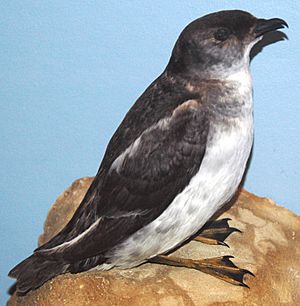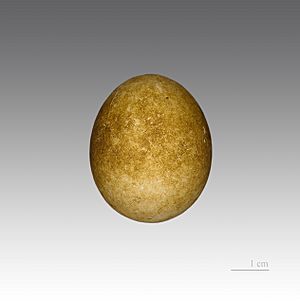South Georgia diving petrel facts for kids
Quick facts for kids South Georgia diving petrel |
|
|---|---|
 |
|
| Conservation status | |
| Scientific classification | |
| Genus: |
Pelecanoides
|
| Species: |
georgicus
|
The South Georgia diving petrel is a small seabird. It is one of five types of "diving petrels." These birds look a bit like small auks. You can find them in the southern parts of the Atlantic and Indian Oceans. They also live near islands off southeastern Australia.
Contents
About the South Georgia Diving Petrel
This bird was first described in 1916. Two scientists, Robert Cushman Murphy and Francis Harper, named it. They found the bird near the South Georgia islands. That is why its scientific name, georgicus, comes from "Georgia."
What Does It Look Like?
The South Georgia diving petrel is a small, round bird. It is about 18 to 22 centimeters (7 to 8.5 inches) long. It weighs around 90 to 150 grams (3 to 5 ounces). Its back is black, and its belly is dull white. It has a short, black beak with light blue edges. Its wings have thin white stripes. The bird's face and neck can look more brown than black. Its legs are blue with black lines on the back.
It looks very much like the common diving petrel. You might not tell them apart unless you are very close. One small difference is in their wing feathers. The South Georgia diving petrel has lighter inner feathers. The common diving petrel also has a smaller, narrower beak.
Where Do They Live?
These birds live in groups called colonies. They make their nests on islands in the Subantarctic region. You can find them breeding on South Georgia Island in the South Atlantic. They also live on islands like the Prince Edward Islands, Crozet Islands, and Kerguelen Islands. These islands are in the southern Indian Ocean. Sometimes, they fly to nearby seas. A few have even been seen in the Falkland Islands and Australia.
They usually build their nests in burrows. These burrows can be about 1.5 meters (5 feet) long. They often dig them on rocky slopes above plants. Sometimes, they build them on flat land too.
Life and Habits
What Do They Eat?
The South Georgia diving petrel mainly eats tiny ocean creatures. These are called planktonic crustaceans, especially krill. They also eat small fish and young cephalopods, like squid.
Reproduction and Life Cycle
The breeding season for these birds is from October to February. The female bird lays one egg. The parents take turns sitting on the egg. This is called incubation. It takes about 44 to 52 days for the egg to hatch. After hatching, the young bird stays in the nest. It takes about 43 to 60 days for it to grow feathers and learn to fly. This is called fledging.
Amazing Divers
South Georgia diving petrels are known for being excellent divers. They are among the best divers in their group of birds. They can dive very deep underwater. Some have been recorded diving as deep as 48.6 meters (160 feet). Most of their dives are between 20.4 and 24.4 meters (67 to 80 feet) deep.
Threats to the Birds
Some animals can be dangerous to the South Georgia diving petrel. These include skuas, cats, and rats.
See also
 In Spanish: Potoyunco de Georgia para niños
In Spanish: Potoyunco de Georgia para niños



